Restaurant Website Design: 10 Proven Tips for Designing the Perfect Site

How to Make Your Restaurant Website Design Look Great: Tips and Examples
Assuming you are strictly confined online, what will make you choose one restaurant over the others? It most certainly has to be the restaurant website design. The reason for this is a website acting as a virtual branch of your restaurant, providing your customers with some portal to the chic interior and exclusive dining experience of your restaurant. As such, if your templates, text, photos, fonts, layout, animation, among other web design attributes are on point, you are better placed to convert each new visitor into a customer.
Thoughtful website design will not just stop there. Instead, it will go on to cover other essentials such as menus, reservation details, location info, contact forms, social media icons, operating hours, staff biographies, and so forth. Suffice it to say; it is not a choice, but rather a rule that you make these components as impressive as possible. After all, the point of all this is to make anyone who visits your website want to eat right away.
So, how can you put everything together to attract customers to your restaurant’s website? Below is a comprehensive guide on creating a stunning site for your restaurant.
Restaurant Website Design – Tell Your Restaurant’s Story
There is bound to be a story, an interesting one for that matter, behind each restaurant. And while you might not know it, your customers want to hear every bit of your tale. So, you have to take the time to arrange your experiences chronologically. Provide the readers with an account, which will give answers to all possible questions. By doing this, you show your potential customers that you run a distinct brand, and you are pleasantly different from the rest.
In the example below, the restaurant’s account provides us with the unique information, specifying the year it was established and the inspiration behind their dishes. It further goes on to give reasons why the restaurant is different from the rest. Fantastic, right? Take a look.
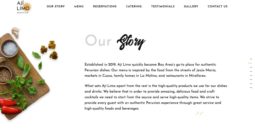
1. Choose Suitable Style Elements in your restaurant website design
The font, color, and design of your website should complement the vibe your restaurant gives off and the one you want to put out there. In that regard, picking an edgy font shows that the restaurant is at the fore of championing a new trend. On the other hand, a laid-back font, color scheme, and design mean that the restaurant is more casual.
In the example below, the restaurant does well in blending different fonts, for the brand name, page title, and website menu. When it comes to colors, grey is used for the top menu, white for the rest of the surface, and black for the footer. The presence of a spice photograph accentuates the design.

2. Get the Navigation Right
The visitors on your site deserve an excellent experience. They should be able to move around on your website, seeing whatever image they want and reading anything that piques their interest. When designing a site for a restaurant, you can choose the classic top navigation bar, where all components are provided in a list. Alternatively, you can select a vertical navigation bar that pops up upon the click of a button or stays static on the web page.
In the following example, the restaurant takes an unconventional approach by putting the website’s main menu at the bottom. After all, who said it should always be at the top?

Note, you can always make your navigation more engaging by incorporating videos and parallax scrolling.
3. Write Your Menu in the Correct Format
The menu is one of the most visited pages of a restaurant’s website. For this, it should be very appealing, easy-to-use, and responsive. To create an effective menu, you have to type the available dishes directly onto the website. This way, the details can scale and be parsed on various search engines. To give your mobile visitors an easy time, consider putting the menu on its own page leaving off any clicks.
What you need to gain from all this is never to upload JPG or PDF versions of the menu. Why? For one, the content will be harder to read on a smartphone or tablet. Two, since a photo or a PDF menu, cannot be indexed well, putting them on your site will affect the ranking of your restaurant’s website negatively.
Here is an excellent way to go about it courtesy of Bolivian Llama Party, New York.
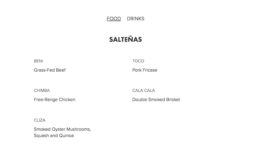
4. Provide Simple Contact and Feedback Forms
Each website, especially one for a restaurant, should have a contact form. Now, when availing the same, you must ensure that it is easy to fill out. Also, you need to avoid asking for sensitive information such as phone numbers and physical addresses. Instead, provide fields for an email address, subject, name, and message.
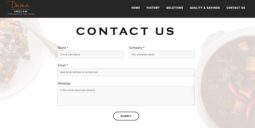
Regarding feedback forms, you must make them simple too. Providing one with a name field, rating section, and an area to offer a short review is enough. All said, with forms, the simpler they are, the better since they are less intimidating.
5. Include Location Details and Operating Hours
A potential customer will be interested in knowing where your restaurant is located, the hours you are open, and, most of all, how to get there. So, if you want to increase your chances of landing and converting clients, these details should be easily accessible on your website. Most modern restaurant sites include a digital map with the marked location. You can always use Google Maps for this.
You should also consider adding a contact mobile number with the appropriate tags so that customers can contact you conveniently if they need it. So, where does this information fit in your site design? You can create a ‘Contact Us’ page, place it in the ‘About Us’ page of your website. Alternatively, you can put it in the footer. Here’s an example:
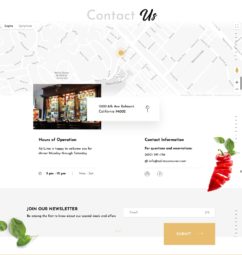
6. Link Your Instagram to Showcase Photos
You want customers to want to dine at your restaurant. Therefore, you have to entice them with pictures of the delicacies you service at your establishment. By linking your site to your Instagram, the photos you post to your gram will automatically be showcased your website as well. You can add this functionality to your site using a plugin or by getting it customized by a qualified website designer.
Sharing high-quality photos of the foods you have on your menu are key to attracting customers to your restaurant. You can add a description of each dish that customers can see when they hover over a picture. Make sure you add posts consistently so that visitors have something new to see whenever they visit your site and Instagram page. Case-in-point:

7. Restaurant Website Design – Integrate Videos
To make your restaurant design stand out and grab your visitors’ attention, consider incorporating videos. The videos can be about anything from showing off your dining area to how meals in your restaurant are cooked. You can also use a video to tell customers your story. Either way, videos are great for capturing the attention of potential customers. And, people tend to remember what they see than what they read for longer.
However, don’t overdo your videos as it may be counterproductive. Balance them out with other forms of content too. An example of a restaurant site that has integrated videos:

8. Utilize Graphics
You can use graphics as a creative way to display processes within your restaurant. For example, how to order, prepare a particular meal, etc. Adding graphics to your site can not only add style to your menus but also help customers to understand how different processes on your site work. Make it enjoyable yet simple to make customers feel more at ease when dining at your establishment. Example of a site that has used graphics to show their ordering process:
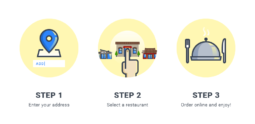
9. Create a Blog
Visitors to your site would want to know more about your chefs, how you prepare your meals, where you source your ingredients, special qualities about your restaurant, among many more things. The best place to share all these details is in a blog. So, create a blog section on your site and post relevant content there.
If you can’t write or you don’t have the time to do it, you can hire a qualified blogger to do the work for you. Apart from engaging your customers, a blog can also enhance your search engine ranking through keyword optimization. An example of a restaurant website blog:
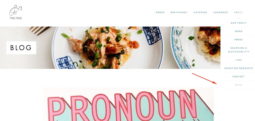
10. Remember to Design for Mobile
Remember, the majority of people look up restaurant options on their phones. So, if you want to enhance your customer experience when on your site, optimize your restaurant website design for mobile. Make sure your menu, reservation form, and other essential elements are easy to view and navigate on mobile. Write your menu down in text rather than uploading a PDF and cross-check on various devices. An example of a mobile-optimized menu:
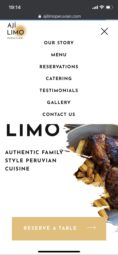
Restaurant Website Design – Final Words
Having a poor website design can hurt your business. So, if you want to sell your restaurant as a high-quality dining experience, your website design should also be of high-quality. Remember, the first impression matters, and once people form an opinion about your restaurant, it’s difficult to change their minds. Invest time in designing your website or get assistance from an experienced website developer.
